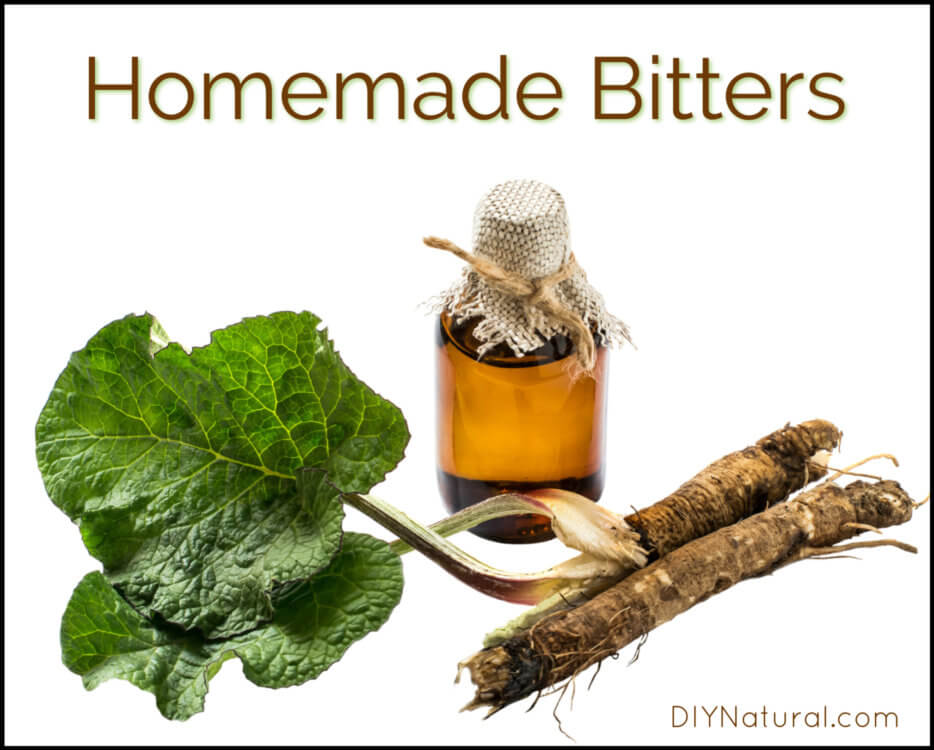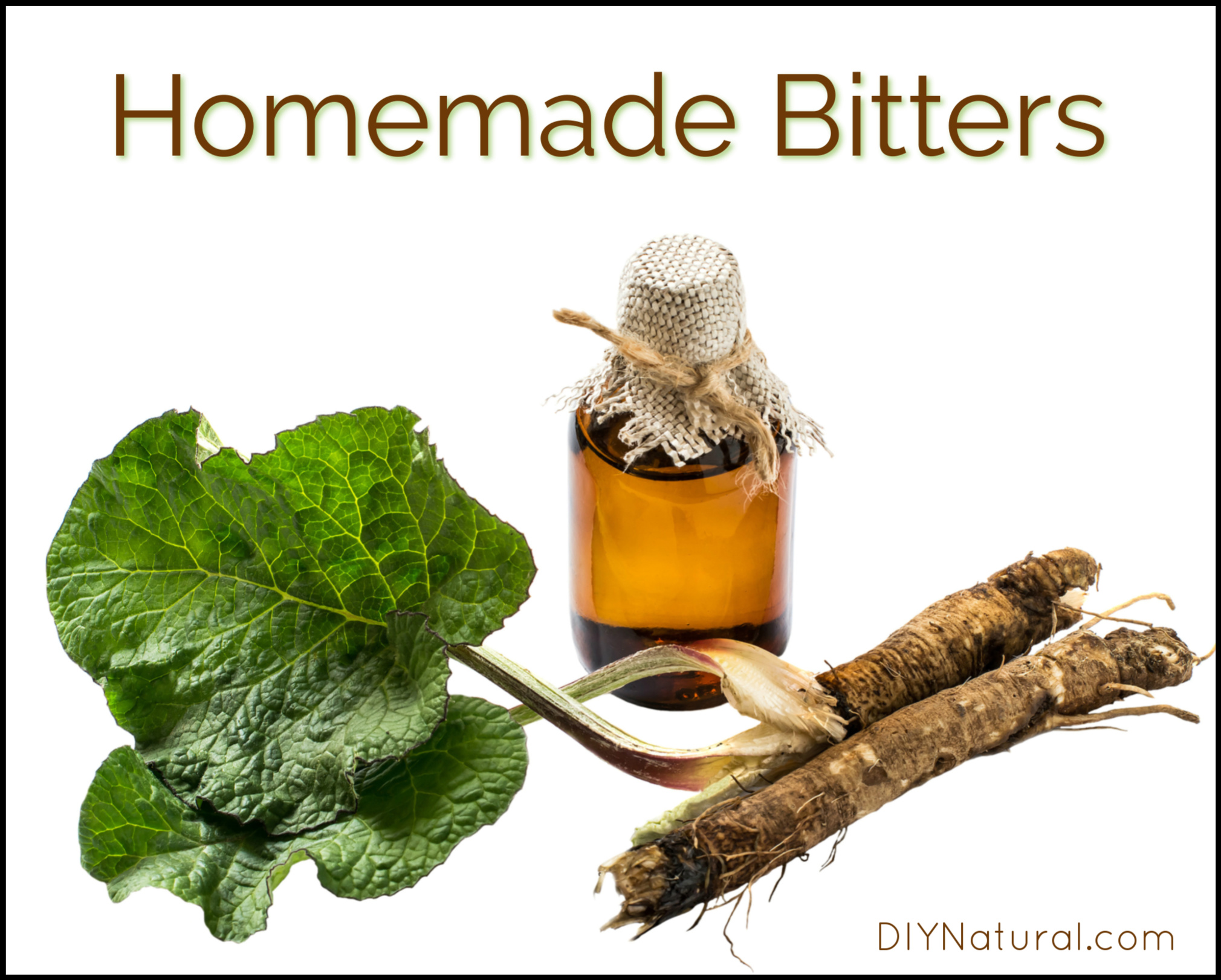
I learned how to make bitters because homemade bitters have many medicinal and culinary uses, and now I control the ingredients, the alcohol, and the flavor.
I first heard about bitters in an herbal medicine class. The thought of using something bitter to aid in digestion intrigued me. I began to research the subject and finally started making my own.
What are Bitters?
They are either a tincture made of different herbs and other ingredients, or several tinctures blended together. Both work; you just need to figure out which works best for you. I’m usually running short on time or space, so I tend to do the latter.
How to Use Bitters
Once your mixture is tinctured, the homemade bitters that are produced can be used as a medicine, a drink ingredient, or a cooking ingredient. Anywhere you want a bitter edge or a more pronounced bitter taste, you can use your bitters there.
Drink Ingredient
Bitters are commonly used in mixed drinks, such as the Old Fashioned. This consists of whiskey, bitters, sugar, and water. You can also make a bitters tonic by adding a few drops of bitters to a glass of sparkling water.
Digestive Aid
Bitters can be used to aid in digestion as they stimulate bile production. A few drops of homemade bitters on your tongue is all you need to jump start your digestive juices.
Cooking
Try adding a few drops of bitters to the next batch of jam that you make. It helps to make them not quite so sweet, but in a different way than sour would be.
How to Make Bitters
Method A: Separate Tinctures for Combining Later
A tincture is an alcohol infusion that has steeped over several weeks. I use the “folk method” whenever I make tinctures. This is the easiest method to make tinctures when you do not need specific dosing.
Step 1: Make Separate Tinctures
1. Fill a pint jar halfway with dried botanicals. Cover with alcohol (such as 40% or higher vodka), cap the jar, shake, and place in the sun for a few weeks.
2. When done, strain and store in a cool, dark place.
A list of herbs for tinctures is given below. With this method, you’ll make each herb in separate jars, tincture them alone, and then combine them when the herbs are finished.
Step 2: Combining the Tinctures
In general, you’ll want to go heavy on the citrus/herb component, light on the bittering agent, and very light on any sweetener you may want. For example, 12 drops orange peel tincture, 2 drops gentian tincture, 2 drops allspice tincture and 1 drop clove tincture. You’ll want to adjust this to your tastes.
Method B: Everything Blended Together
This is the method I prefer because it is all mixed together and I don’t have so many bottles going at once.
1. In a pint jar, add 10 teaspoons coffee beans, 3 teaspoons cocoa nibs, 2 teaspoons mugwort, 1 teaspoon cinnamon chips, and a teaspoon or so of molasses to taste. This should make the jar about half full.
2. Cover with alcohol (vodka at 40% or higher), cap, shake and set in the sun for a few weeks. When done, strain and store in a dark, cool place.
Note: This is just one recipe that you can make. See the Homemade Bitters Recipes section below for recipe suggestions.
Ideas for Flavoring Categories (Use for Method A)
The main categories are herb/citrus, bittering agent, spice/herb and sweetener if you choose. Here are a few ideas.
Herb/Citrus
- orange peel
- grapefruit peel
- lime peel
- lavender
- chamomile
- lemon balm
- mint
(Find all of these dried herbs/citrus peels here.)
Bittering Agents
- angelica root
- burdock root
- dandelion root and leaf
- barberry, Oregon grape root or yellowroot
- marshmallow root
- licorice root
- gentian root
- wild cherry bark
(Find all of these dried roots here.)
Spices/Herbs
- coffee beans
- cocoa nibs
- toasted nuts (especially pecans)
- vegetables such as beets or carrots
- fruits such as peaches or apples
- cinnamon chips
- whole cloves
(Find many of these spices/herbs here.)
Sweeteners
- honey
- molasses
- agave
- stevia
- monk fruit
- simple syrup
What you use in your blend is up to you. Go light on the bittering agent as they tend to go a long way. With herbs such as gentian, you may want to cut back to 1 teaspoon. Gentian is known for being one of the most bitter things on earth! You don’t need to sweeten your homemade bitters, but some people prefer to.
Homemade Bitters Recipes (Use for Method B)
Here are some thoughts on putting together your homemade bitters blends. You can find most of the following ingredients here. NOTE: Dried herbs (not fresh) are used in each recipe.
Lavender
10 teaspoons lavender buds, 5 teaspoons chamomile flowers, 1 teaspoon mugwort, 1 teaspoon honey
Citrus
6 teaspoons orange peel, 4 teaspoons lemon peel, 1 teaspoon lime peel, 1 teaspoon Oregon grape root, a sprinkle of stevia
Warm Spice
4 teaspoons orange peel, 1 teaspoon burdock root, 1 teaspoon molasses, 1 teaspoon each cinnamon chips, cloves, and cardamom
Spring Tonic
5 teaspoons dandelion root, 3 teaspoons dandelion leaf, 1 teaspoon marshmallow root, 1 teaspoon chickweed herb, 1 teaspoon honey
Wild and Wooly
4 teaspoons elderberries, 2 teaspoons hawthorn berries, 2 teaspoons mugwort, 2 teaspoons blackberries, 1 teaspoon wild cherry bark, 1 teaspoon honey
Homemade Bitters Without Alcohol
If you don’t want to use alcohol, you can make these with liquid vegetable glycerin. It won’t be a true bitter as alcohol is mainly used as the solvent, but you would get somewhat of the same effect. You’ll want to omit the sweetener as glycerin is naturally sweet.
You could also try these as an herbal tea. Again, it won’t be quite the same, but close.
Note: We also tried making bitters from hops.
Do you know how to make bitters? If so, tell us how you do it!
*******




Am so grateful for receiving such a wonderful mail st my time of need. God bless u
Great ideas & recipes.Like your processes